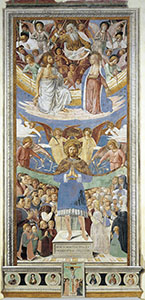
Saint Sebastian, Church of St. Augustine, San Gimignano.
In the church of Saint Augustine, Benozzo created a votive fresco commissioned by the Augustinians following the plague that struck the town in 1464. It is certain that, in order to carry out this work, the artist broke off his decoration of the main chapel with the Episodes from the life of Saint Augustine. The iconography of this fresco is quite unusual compared to traditional representations in which Saint Sebastian is clad only in a loincloth and tied to a tree or column. Here, the saint is shown standing on a pedestal supported by angels and dressed in a tunicle tied at the waist and a large cloak opened to protect the population praying at his feet, as indicated by inscription on the pedestal, which reads SANCTE SEBASTIANE INTERCEDE PRODEVOTO POPOLO TVO. Another inscription on the painted marble floor indicates the date of completion as 28th July 1464.
In the upper register, God the Father, surrounded by seraphim, is depicted gripping an arrow he is about to hurl against mankind. Beneath him, Mary bears her breast and Jesus exhibits his wounds as a reminder of the sacrifice made for the redemption of the world in an attempt to intercede against the wrath of the Father.
Using a sophisticated optical effect characteristic of Benozzo's style, the fresco seeks to create the impression of a great altarpiece enclosed within a false marble frame. This optical illusion is enhanced by the small pax of the Crucifixion, painted as a small tablet resting on the altar below it. The Augustinian friar portrayed kneeling at the foot of the Crucifix has been identified by scholars as Fra' Domenico Strambi, the patron of the cycle of episodes from the life of Saint Augustine. The inscription "F.D.M.P" which accompanies the representation perhaps stands for "Frater Dominicus Magister Parisinus" and would seem to substantiate this hypothesis.
The recent restoration carried out in 1990 established that the fresco was created in just sixteen days, hence with a certain haste, allowing the artist to continue his work on the chapel of the church choir.
Some two years later, Benozzo painted another fresco featuring the same subject on the counter-façade of the Collegiate Church of Santa Maria Assunta in San Gimignano.
Serena Nocentini